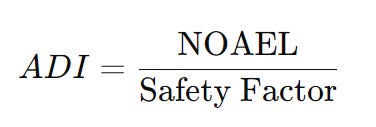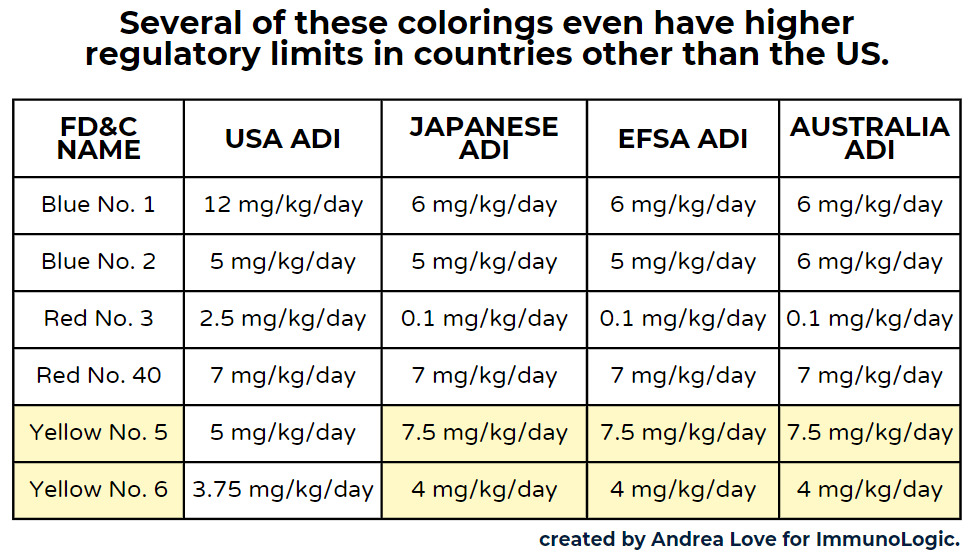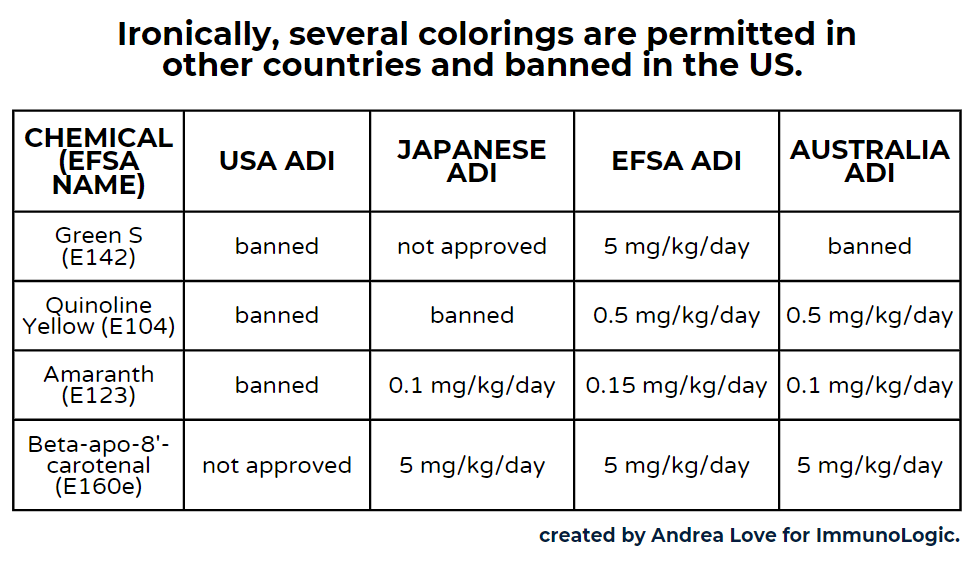Are food dyes used in the US banned in other countries? No, not really.
Rampant misinformation that is not fact-checked help legitimize falsehoods that undermine science, public health, and food safety.
A common trope that often circulates when the likes of Vani Hari get a megaphone are false claims that suggest the US food supply is filled with “poison” food colorings that other countries don’t allow. Because of that, they like to spread fear and undermine the safety of our food supply.
Hate to break it to her, Gavin Newsom, and pretty much every media outlet, but this is false. Unfortunately, because anti-science lobbyists like the EWG and Consumer Reports plus social media influencers have influence and in our society, these falsehoods become entrenched as strongly-held beliefs by far too many.
Food dyes that are permitted in the US are not banned in other countries.
There is more to discuss when it comes to how foods are regulated in other countries, but I’m going to save that for a longer piece, because regulatory is a really complex topic and I want to give it proper attention.
But since the recent California Assembly Bill 2316 that I discussed here bans certain food dyes based on their purported “health impacts,” I wanted to follow up specifically on comments and questions from various individuals, which center around the question: “why are these in US foods if they’re not in other country’s foods?”
And the answer is: they are in other country’s foods.
Unfortunately, if you don’t understand how food ingredients and food safety is monitored and regulated, you likely aren’t aware of the fact that these substances have colloquial names based on the agency that regulates them in a given country.
For example: California AB 2316 bans the inclusion of Blue 1, Blue 2, Red 40, Yellow 5, and Yellow 6. Last year, California AB 418 banned Red 3. But these aren’t their official names, these are the names put forth by the US Food and Drug Administration. FDA uses designations called FD&C, which stands for Food, Drug, and Cosmetic, for colorings approved for use in - yep - food, drugs, and cosmetics in the USA.
The official chemical names for these?
Brilliant Blue FCF, Indigotine, Erythrosine, Allura Red AC, Tartrazine, Sunset Yellow FCF
These food ingredients have different names in other countries.
In the European Union and the UK, food colorings are named by E-number as denoted by the European Food Safety Authority (EFSA). For example, Yellow number 5 is called E102 in the EU.
The same is true for Japan, Australia, and other countries: their colloquial name is based on their regulatory agency nomenclature.
These food dyes aren’t banned in other countries.
Why did not a single media outlet bother to fact-check any of this, ever? I have honestly no idea. But it does so much irreparable harm to society at large.
Does the US allow much more of these food dyes to be consumed?
Another common claim is that the FDA is somehow corrupt and they just let harmful chemicals run rampant in our foods, whereas other countries care about what’s in their foods.
This is also not true.
How safety thresholds are determined by each country are impacted by the regulatory processes and methods. This is impacted by whether the country set safety thresholds based on risk assessment or hazard analysis (see here for more on this difference).
But beyond that, safety threshold for food colorants are defined by the acceptable daily intake (ADI) level. ADI is the maximum amount that someone can consume - every day - over the entire course of their life without a health risk.
As such, the ADI value is an extremely conservative level based on the fact that this represents cumulative exposure over years and years.
But a couple of other factors are involved in how a country defines an ADI, including the No-Observed-Adverse-Effect Level (NOAEL) and the human equivalent dose (HED).
The NOAEL is the value at which point no adverse effects have been detected in animal studies. This is determined after extensive controlled experiments. The NOAEL is one of the benchmarks for toxicological assessment in humans, and includes adverse effects related to acute toxicity, reproductive and development harms, and chronic symptoms such as cancer.
The HED is a conversion of the NOAEL to a human dosage. There is a specific conversion that is implemented based on a relationship between species that NOAEL levels were determined in versus humans. This species conversion factors in differences in body weight, surface area to mass ratio, metabolic differences, and other physiological factors.
The ADI applies an additional safety factor to the HED.
Because we can’t study every single human on the planet, additional safety factors are included to be even more conservative after determining the NOAEL and HED. For example, a typical safety factor is 100, meaning the HED value is divided by 100, to reduce the daily intake 100-times lower than the HED. This includes a 10-fold species factor plus a 10-fold human variability factor.
In some instances, additional 10-fold safety factors are incorporated to account for certain rare or high-risk populations. In the end, this gives an extremely conservative level that will minimize potential risks after long-term exposure to any substance.
ADI levels for food colorings vary between countries, with some safety thresholds being more strict in the US.
As mentioned, regulatory review and decision-making varies country-by-country, but even simply comparing the ADI thresholds between the US, Japan, EU, and Australia, you can see that not only are these colorings not banned in other countries, but several have higher ADI values than what are approved in the US.
For example, Yellow 5 has an ADI threshold of 5 mg/kg of body weight per day in the US, whereas the ADI in Japan, EU, and Australia is 1.5-times higher, at 7.5 mg/kg of body weight per day. Similarly, Yellow 6 has an ADI of 3.75 mg/kg of body weight per day in the US, compared to 4 mg/kg of body weight per day in Japan, EU, and Australia.
Interesting how this is never mentioned, huh?
Wonder what the EWG, Gavin Newsom, Food Babe, RFK Jr., et al. would say about this?
It gets better.
There are several food dyes approved in Europe that are prohibited in the US.
Ironically, in the European Union, there are a few food dyes that are allowed but are either banned, not approved, or restricted for use in the United States.
E142, also known as Green S, is permitted for use in the EU in foods like canned peas, beverages, and confectionery and candies. But Green S is banned in the US, Australia, and Japan because of potential safety concerns.
E104, also known as Quinoline Yellow, is approved and permitted for use in the EU in soft drinks, desserts, and candies. It’s also approved at the same ADI level in Australia. Quinoline Yellow is banned in the US and Japan because of potential safety concerns.
E160e, also known as Beta-apo-8’-carotenal is used in the EU for desserts and beverages. It is also approved for use in Australia and Japan, yet not approved in the US for use.
E123, also known amaranth, is allowed in the EU in certain foods like caviar and alcohols at an ADI of 0.15 mg/kg body weight per day. It’s also approved in Australia and Japan, yet has been banned in the US since 1976 because of cancer incidence among laboratory animals.
Why are these food colorings that are allowed in the EU but prohibited in the US not a subject of discussion?
Well, I’ll give you a few guesses. But it’s primarily because if people who spread chemophobia and influenced public perception and opinion had to concede this, it would erode their claims that the US food supply is “worse” than other countries.
In reality, how substances are regulated in one country versus another should solely be based on the full breadth of available scientific evidence, but as we have seen, is often distorted, skewed, and influenced by politicians, powerful lobbying groups, and public outcry.
In all countries, food colorings and all food ingredients are regulated by their overseeing agencies that are filled with relevant scientific experts. They continually review all available evidence: in vitro, animal studies, in silico analysis, clinical studies, epidemiological data, and more. They provide guidance and recommendations if data emerge that require a reassessment of ADI and/or other safety considerations of everything we eat.
The US doesn’t use inferior methods compared to other countries. Whether something is regulated differently in one country or another isn’t an automatic indication of one country being right or wrong: it is an indication of a confluence of many factors beyond the scientific safety data, including politics and belief systems in that country (or state, looking at you, California).
Clickbait misinformation impacts public perception, beliefs, and opinions, which influences media, policy, and legislation. If we want to improve the quality and quantity of our lives through evidence-based measures, we all must play an active part in drowning out the disinformation with factual content.
When the autonomy of scientific experts is undermined by celebrities, vocal personalities, politicians, and anti-science activists, it harms our society, it harms public health, and it harms trust in science.
Thank you for supporting evidence-based science communication. With outbreaks of preventable diseases, refusal of evidence-based medical interventions, propagation of pseudoscience by prominent public “personalities”, it’s needed now more than ever.
Stay skeptical,
Andrea
“ImmunoLogic” is written by Dr. Andrea Love, PhD - immunologist and microbiologist. She works full-time in life sciences biotech and has had a lifelong passion for closing the science literacy gap and combating pseudoscience and health misinformation as far back as her childhood. This newsletter and her science communication on her social media pages are born from that passion. Follow on Instagram, Threads, Twitter, and Facebook, or support the newsletter by subscribing below:








Love this so much. Thank you!
This is SO helpful! For many of us who are not scientists, we recognize chemophobia when we hear it, but we don't know how to counter this with facts. You continue to provide helpful data in an accessible way. Thank you!